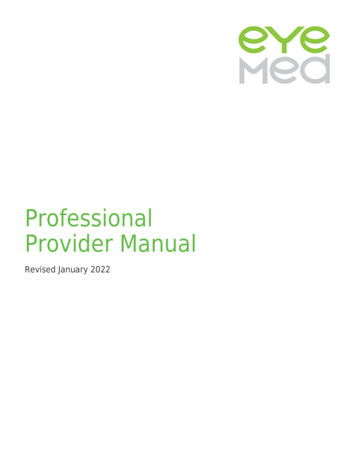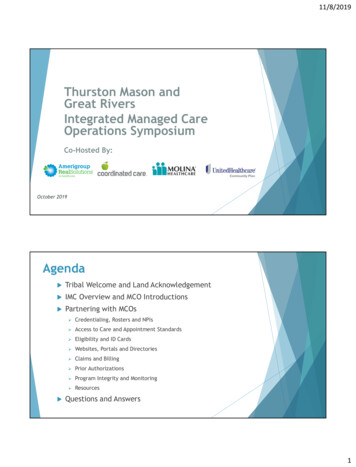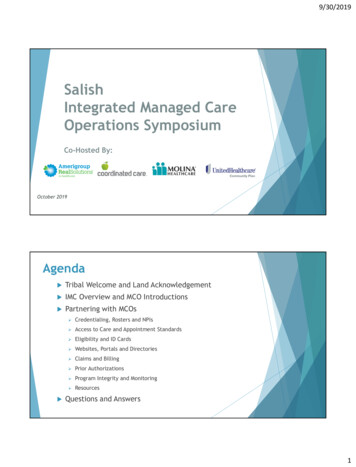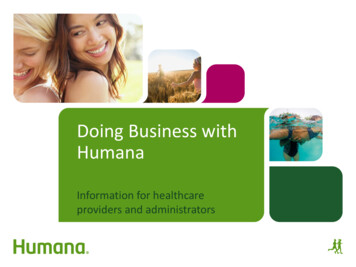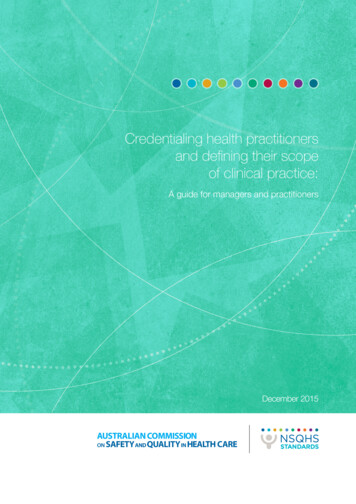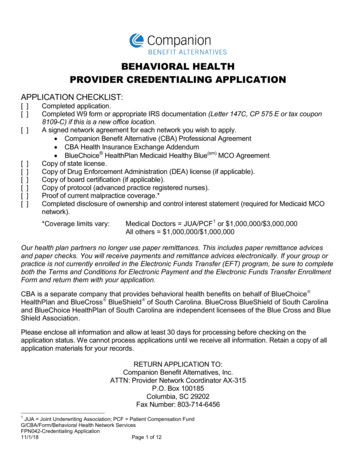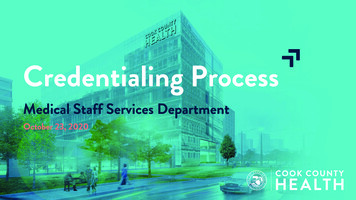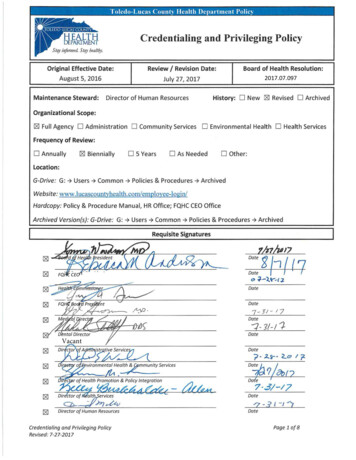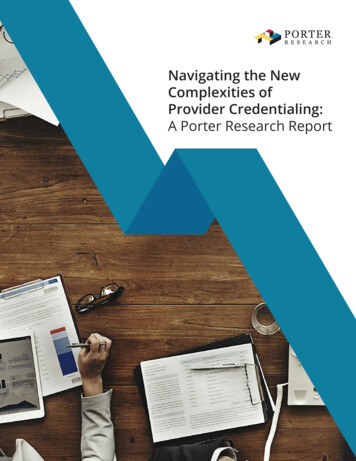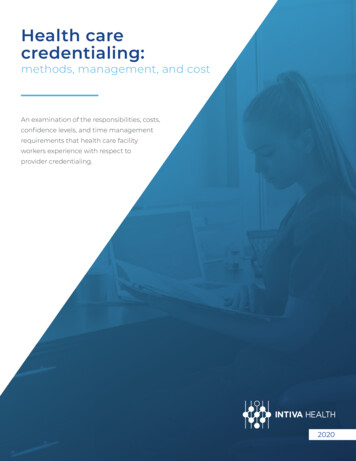
Transcription
Health carecredentialing:methods, management, and costAn examination of the responsibilities, costs,confidence levels, and time managementrequirements that health care facilityworkers experience with respect toprovider credentialing.2020
Excutive summaryHospitals and other health care organizations have traditionally viewed credentialing as aregulatory burden. More continuous monitoring is neglected because of the time and cost involvedwith manually validating employee records against various primary sources--potentially affectingthe quality of patient care. Intiva Health conducted a survey that involved medical staff in a varietyof health care facilities. Participants detailed the various hurdles involved with credentialingproviders. Based upon the results of the survey, there are multiple avenues in which the IntivaHealth Ready Doc platform can save health care facilities time and money with near-instantverification of necessary documents for credential management.intivahealth.com2
Table of contentsIntroduction4Importance of credentialing5Cost implications of credentialing7Inefficiencies beyond credentialing10Time and confidence11Summary12Ready Doc: An Intiva Health solution to credentialing13References17
IntroductionThroughout the past 20 years, the credential management process within the health care sectorhas become complex and onerous primarily due to the expansion of the provider scope of practice,accrediting bodies, and requirements of third-party payers like Medicare, Medicaid, and privateinsurers. It can take anywhere from a few weeks to six months to get credentialed.Then, facility staff spends an additional 20 hours per form. If any elements are missing from theapplication, or if a school, employer, or reference doesn’t swiftly respond to verification requests,it can add weeks or even months to the process. All of this time spent waiting on credentials isprecious time lost that could be utilized focusing on patient care, and ultimately represents a lossof revenue for the health care facility.The credential management process must bere-done every two years in addition to fulfillingcontinuing medical education (CME) requirements.In combination with other non-clinical paperwork,this administrative burden takes up nearly ninehours a week for the average doctor, according toa study published in the International Journal ofHealth Services (Woolhandler & Himmelstein 2014).ON AVERAGE TOCREDENTIAL A PHYSICIANA recent survey conducted by Intiva Health showsthat despite all of the intricacies involved withcredential management, a majority of health careworkers still endure the process either manually,with electronic spreadsheet documents, or proprietary software. However, our survey shows thatnone of these methods provides complete confidence that they are executing the process correctlyor efficiently.intivahealth.com4
Importance of credentialingCredentialing is a process that utilizes an established series of guidelines to ensure that patientsreceive the highest level of care from practitioners who have undergone the most stringentscrutiny regarding their ability to practice medicine. The process assures the patient that he orshe is being treated by providers whose training, qualifications, licensure, and ability to practicemedicine are acceptable and ensures that all health care workers are held to the same standard.Credential management is vital for all health care institutions and is a process that must beperformed to ensure that health care workers providing the clinical services are qualified to do so(Patel & Sharma 2019).When a physician applies to practice within a health care facility, they are asked to complete anapplication and allow a credentialing entity to research their professional documents. Problemsbegin when there are inaccuracies and discrepancies between various records.Health care facilities have a legal responsibility to verify a provider’s identity, education,work experience, malpractice history, and license verifications to protect patients fromunqualified providers.Reasons for not using credentialing softwareintivahealth.com5
According to an article in Healthcare Innovation (2011), one small human error in handling theclutter of paper documentation necessary for credentialing can result in a nurse being authorizedto perform services beyond experience, or a physician with an expired license being allowed tocontinue to practice. These outcomes can have serious, negative consequences on patient safety, aphysician’s professional survival, and the reputation of an affiliated institution.The importance of maintaining up-to-date provider credentials is crucial for institutional protectionand excellence in patient care. However, many health care organizations only check credentials atthe time of hire and then once every two or three years. More continuous monitoring is neglectedbecause of the time and cost involved with the predominant method of manually validatingemployee records against various primary sources.Credentialing methodsThe administrative burden associated with the manual process, and a failure to implementautomated systems that would ease the burden and ensure consistent compliance, directly resultsfrom a lack of awareness and lack of understanding concerning the cost benefits, risk mitigation,and general efficiency of an electronic credentialing system.intivahealth.com6
Any negligence that may occur can have a detrimental impact on patient care. All health careinstitutions are responsible for ensuring that their medical staff is certified to do their job throughan established credentialing process. This process is not simply tied to the demonstration ofproper education and training. It also maintains accreditation standards and satisfies federaland state laws.The credentialing process often varies among health care institutions. However, it is crucial thatprimary source verification is conducted to ensure that any papers submitted are not fraudulent.Primary source verification is a verification from the original source of a specific credential, suchas education, training, or licensure, to determine the accuracy of the health careprovider’s qualifications.Some examples of primary source verification include: National Provider Identifier, federal andstate sanctions, state medical board, DEA permits, and medical licensures. An appropriate,methodological credentialing process can prevent admission of fraudulent health care workerswith questionable qualifications, which yet again ensures a better quality of patient care andprotects the reputation of the health care institution. Once credentialed, it is crucial that all healthcare workers are repeatedly audited for their performance (Patel & Sharma 2019).Cost implications of credentialingA slow credentialing process costs health care providers, facilities, and the industry at-large anexorbitant amount of money. Delays cost providers thousands of dollars in lost income—the exactamount of which depends on how much they earn and how long it takes to get credentialed. Fora physician making the average income of nearly 300,000 a year, waiting a few weeks would costthe provider around 25,000 in lost income. The worst-case scenario of waiting six months wouldcost the provider around 150,000 in lost income.intivahealth.com7
Slow credentialing represents a loss of revenue for individual facilities as well. According to a surveyconducted by Merritt Hawkins, a single physician earns a facility an average of more than 2 millionper year. If credentialing that physician takes a few weeks, the facility would lose around 150,000 inrevenue. If it takes a few months, that equates to hundreds of thousands of dollars in lost revenuefor the facility. 400,00IN REVENUE LOSTThis problem affects more than a few physicians and facilities, it affects the entire health careindustry. As an Institute of Medicine study found, the United States wastes half of the estimated 361 billion a year it spends on health care administration. That amount is more than twice thenation’s total spending on heart disease and three times its spending on cancer (Cutler 2012).While that administrative waste is not solely accounted for by credential management processes,slow credentialing still costs the industry billions of dollars a year on its own.intivahealth.com8
Inefficiencies beyond credentialingThe procedure involving new hires of health care workers at a facility and letting them get to workdoes not stop with credentialing. Once the credentialing process is completed, the process ofgranting or denying privileges begins (Matthews et. al 2017). According to the American MedicalAssociation’s (AMA) Principle of Medical Ethics, the purpose of privileging is to improve theefficiency and quality of patient care in the hospital. The AMA states in their Code of Medical EthicsOpinion 9.5.2 that the process can be divided into two categories: what to base privilege decisionson and what to avoid basing privilege decisions on:Base privilegeBase privilegedecisionsdecisionson the: on the:Avoid basingAvoid privilegebasing Numbersof patientsof patientsthe candidatethe candidatehas admittedhas admittedto the facilityto the facilityAvailabilityAvailabilityof facilitiesof facilitiesEconomicEconomicor insuranceor insurancestatus ofstatus ofpatientspatientsadmittedadmittedby the candidateby the candidateOverall medicalOverall medicalneeds ofneedsthe community,of the community,the hospital,the hospital,and especiallyand especiallypatientspatientsPersonalPersonalf riendships,f urisdictionaldisputes,disputes,or fear oforcompetitionfear of competitionOnce a determination about privileges has been established, many health care institutions havedeveloped a monitoring period. This is especially important for surgeons (Sachdeva et. al 2016). Insome situations, only a retrospective chart review of patient medical records may be feasible. It isimportant that this review is conducted randomly on all health care workers who care for patientsto ensure that they are compliant with all essential job functions such as the format of writingmedical notes, providing dates for each entry, checking the laboratory framework, and doublechecking any abnormal results (Patel & Sharma 2019).intivahealth.com10
Time and confidenceParticipants in the credentialing process reported that when using Microsoft Excel, it takes nearlythree months on average to credential a provider. Those that completed their credentialingmanually stated that it took an average of more than one month to credential a provider.Participants that used an internal software developed within their organization completed theprocess only two days quicker than those who completed the process manually. Those that usedexternally purchased commercial software to credential a provider reported the process took onaverage nearly one month, more than two weeks faster than those that did the entire process byhand and more than six weeks faster than those using Excel.Credentialing stepsCOLLECTINGCOLLECTINGCONDUCTINGPersonal informationInsurance informationBackground checksCOLLECTINGRECEIVINGHistorical insuranceinformationFinal approvalWith more than half of participants conducting credential management either via Microsoft Excelor a manual method, the majority of the health care industry appears to be spending aroundtwo months to complete the process from start-to-finish. More than half of the participants areconducting credential management via internal proprietary software, but it still takes them morethan a month to complete the process. A small percentage of participants conduct credentialmanagement via purchased software, but it took them almost an entire month on average fromstart to finish.intivahealth.com11
SummaryOn average, participants are spending nearly eight weeks to complete the credentialing process.Whether it is by hand, using Microsoft Excel, or via a type of software that is proprietary orotherwise, survey results show that any of the current methods result in a credentialing processthat is extremely time intensive.Based on the Merrit Hawkins report, our survey results indicate nearly 400,000 in revenue is beinglost on average for the credentialing process to be completed across different sectors of the healthcare industry utilizing diverse methods of credential management.The problem of credentialing in the health care industry is here to stay, and the need for moreefficient solutions is clearly paramount. Current survey results show that a dramatic shift away fromexisting credential management methods is needed. Time, money, and resources are all sacrificedto complete a process that is not only legally required, but necessary for quality health care servicesand successful business operations.The misconceptions concerning health care credentialing software according to our survey arelargely unsubstantiated. With nearly one-third of participants reporting that they did not knowcredential management software existed, an increase in awareness is needed across all sectors ofthe health care workforce.It is critically important to find the most efficient credential management software that providesan “all in one” approach to credential management. There is no need for a step-by-step process toindividually verify the more than 20 documents needed to ensure licenses and education, liabilityclaims, background checks, historical insurance information, and OIG Exclusions. Intiva Healthoffers a single platform that combines all of the necessary documents into one package, along withalerts when credentials are set to expire, via a user-friendly, optimally efficient solution that willprovide measurable cost savings and increased protection for patients, providers, and institutions.intivahealth.com12
An Intiva Health solution to credentialing(View more Intiva Health resources on IntivaHealth.com)Ready Doc is a revolutionary and proprietary credential management solution and is the onlyenterprise product in the market which utilizes distributed ledger technology. Ready Doc createsan immutable, digitized version of credentials and the verification of the credentials whichshortens future verifications from months to minutes. After a medical professional’s credentialsare uploaded and verified in Ready Doc, that person can share the information with any medicalfacility and obtain near-instant privileges at that facility. The software works by generating a uniquetimestamp that can never be altered on the documents after they are uploaded into Ready Docusing a consensus algorithm. This ensures that you most current, unaltered document is availableand further validates the legitimacy of the primary source verification.intivahealth.com14
The result is the elimination of financial losses. This solution is unprecedented and will revolutionizehealth care compliance.Ready Doc also facilitates compliance by automatically monitoring the expiration of credentialsand alerting medical professionals and facilities in advance. This solution allows all credentialcompliance to occur in the same place, dramatically increasing efficiency and reducing the riskof costly lapses in compliance. It is important to note that if a provider’s credentials expire, anymistakes that they make at your facility during this time are not covered by malpractice insurance.Ready Doc provides peace of mind with automatic email reminders for expiring credentials withina selected time frame.The Office of Inspector General (OIG) has the authority to exclude individuals and entities fromfederal health care programs for a variety of reasons, including a conviction for Medicare orMedicaid fraud. Anyone that is excluded cannot receive a payment from federal health careprograms for any items or services they furnish, order, or prescribe. This includes those that providehealth benefits funded directly or indirectly by the United States, other than the Federal EmployeesHealth Benefits Plan. The Office of Inspector Generalmaintains a list of all currently excluded individualsand entities called the List of Excluded Individuals/Entities (LEIE). Anyone who hires an individual orentity on the LEIE may be subject to civil monetarypenalties (CMP). To avoid CMP liability, health careentities must routinely check the list to ensure thatnew hires and current employees are not on it.Ready Doc allows you to check the current status ofa provider’s OIG report at any point in time with OIGExclusions Monitoring. This feature supports instantverification that the provider has no reported issues,saving a health care facility from any penalties andsets aside more time in the day to focus on othertasks of importance.intivahealth.com15
With all of these important health care documents in one place, extra steps have been taken toensure security. Intiva Health determined that the Swirlds Hashgraph platform was the only onethat could meet the stringent security requirements for personal data in the health care space.Hashgraph, similar to Bitcoin’s blockchain, is a distributed ledger providing a decentralized onlinerecord of transactions that can be shared with registered users within the Ready Doc platform.Swirlds is a platform created to build and run fully distributed applications that harness the powerof the cloud without servers. Applications built on the Swirlds platform boost peer-to-peer trustwithout the need for a central server. By leveraging the Hashgraph consensus algorithm, it deliversa high transaction throughput, low consensus latency, and fairness in transaction order.Users can rest assured about the security of their digital documents and the ease of accessibilityReady Doc provides, there are three main benefits of the platform:Save millions in lost revenue Earn revenue by having providers credentialed and ready to work in little time Save 400 to 600 per provider on printing, copying, faxing, paper, and postage Reallocate savings toward equipment, hiring, and patient careCut administrative work Save up to 20 hours of administrative work per provider Get reminded of expiration dates so you don’t spend time tracking them on a spreadsheet Eliminate inefficiencies and redundancies by storing all credentials in one placeBoost security & compliance Stay compliant with automatic expiration reminders Reduce your risk of misplacing or losing documents by having a single platform Ensure all credential documents are received, up to date, and unalteredAll of the above will help to increase the quality of patient care, ensure the highest caliber of thestaff, boost productivity, and save time while increasing revenue.intivahealth.com16
References“2019 Physician Inpatient/Outpatient Revenue Survey.” Merritt Hawkins. Retrieved ent-outpatient-revenue-survey/. Accessed on: November 2019.American Medical Association: Staff Privileges. (n.d.). Retrieved from https://www.ama- assn.org/delivering-care/ethics/staff-privileges. Accessed on: November 2019.Cutler, D., Wikler, E., & Basch, P. (2012). Reducing Administrative Costs and Improvingthe Health Care System. New England Journal of Medicine, 367(20), 1875–1878.doi: 10.1056/nejmp1209711.Mathews BK, Zwank M. Hospital Medicine Point of Care Ultrasound Credentialing: AnExample Protocol. J Hosp Med. 2017 Sep;12(9):767-772.Medical credentialing: More to good health than meets the eye. (July 2011). Retrieved e/13003949/medical- e. Accessed on: November 2019.Patel R, Sharma S. “Credentialing”. StatPearls Publishing; 2019 January. Retrieved . Accessed on: November 2019.Sachdeva AK, Blair PG, Lupi LK. Education and Training to Address Specific Needs Duringthe Career Progression of Surgeons. Surg. Clin. North Am. 2016 Feb;96(1):115-28.Woolhandler, S., & Himmelstein, D. U. (2014). Administrative Work Consumes One- Sixth ofU.S. Physicians Working Hours and Lowers their Career Satisfaction. International Journalof Health Services, 44(4), 635–642. doi: 10.2190/hs.44.4.a.intivahealth.com17
intivahealth.com
Importance of credentialing 5 Cost implications of credentialing 7 Inefficiencies beyond credentialing 10 Time and confidence 11 Summary 12 Ready Doc: An Intiva Health solution to credentialing 13 References 17
